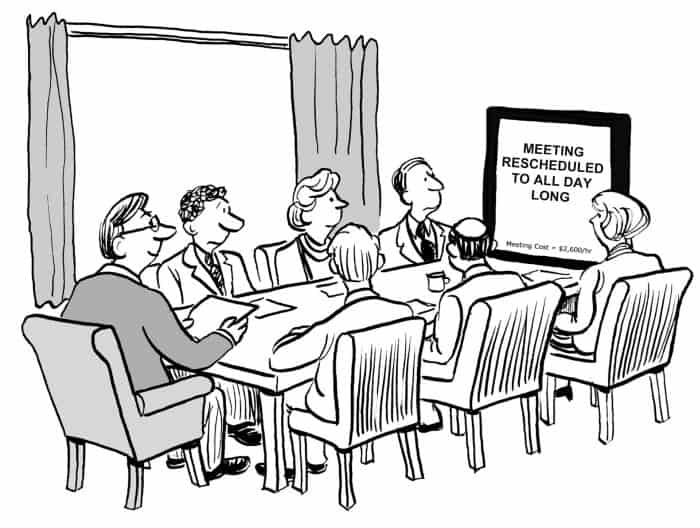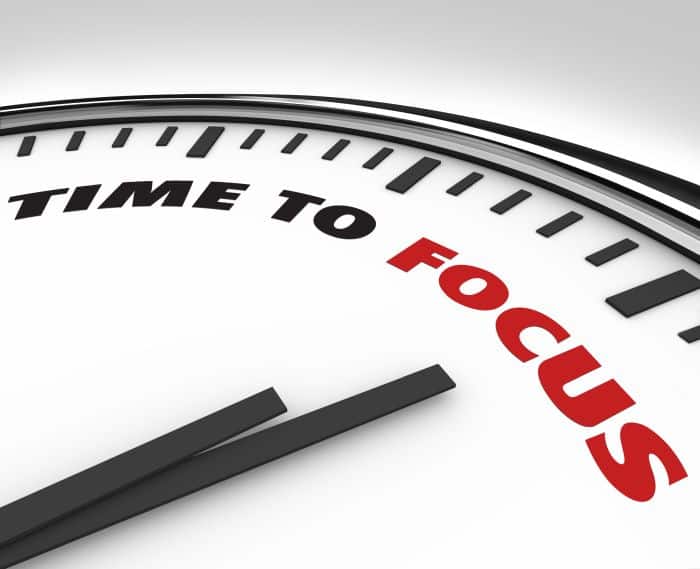Project meetings are nearly essential in most projects. However, many projects spend far too much money on meetings. I have one favourite method to reduce meeting costs. This won’t eliminate all meetings, but it should help reduce the time wasted in project meetings. Show meeting attendees how much each meeting is costing the project.
Table of Contents
Problem: Project meetings cost a lot of time and money
Project meetings take a lot of time. I often hear project staff complaining about how many meetings they are required to go to, or how many meetings there are. Some meetings go much longer than they really should, increasing the time and cost wasted. The length of these meetings is often unnecessary. The cost of project meetings is often much higher than necessary.
Meetings can be expensive to run, depending on how many people are involved and their length of time.
Some meetings also include people that just don’t need to be there. They don’t give any input (or don’t need to), they don’t need anything from that meeting, and they just increase the cost of the meeting. Meeting attendees often don’t come prepared, so they waste meeting time by not having the answers or information needed by others. Some attendees habitually arrive late, leading to wasted time for everyone.
People often don’t focus on the meeting, and spend time on the phone, checking emails etc. They waste the time of others by sometimes needing to be told what is happening (because they were not concentrating).
I have been in some meetings with ten very senior company staff to discuss the current state of a project and to plan the next steps. These were people with an FBLR of about $400 per hour or sometimes more, and even the cheapest person was over $200 per hour. In this sort of meeting, it is easy for the cost to be $3k to $4k or more per hour.
The lack of adherence to start times (i.e. turning up late), coming unprepared, or reading emails during the meeting (and not concentrating on the meeting) often meant the meeting went for two or more hours when it really should have taken less than an hour.
Some of the links on this website may be affiliate links to products I use, have tested or am familiar with. I may receive a commission if you click on some of those links and make a purchase. This is at no additional cost to you.
None of this is ideal. Much or most of the wasted time could be reduced or eliminated completely, if people tried.
What can you do?
- How can you reduce project meeting costs?
- How can you make project meetings shorter?
- How can you get only the necessary people to attend project meetings?
- How can you get people in meetings to focus on getting things done in a timely manner?
Solution: Display the cost of the meeting
There are many ways to encourage more efficient meetings. A few include ensuring everyone goes to meetings prepared, starting meetings on time, ensuring every meeting has an agenda attached to the invite, and having good meeting minutes.
It is often easier to encourage project team members junior or younger than yourself to come prepared or on time, as they are usually required or motivated to do what is asked of them. More senior staff are often more difficult to push to adhere to meeting requirements. This is where time cost comes in to play.
One of my favourite ways to reduce the cost of meetings is to display the cost of the meeting for all the attendees to see.
This can be a simple written note on the corner of the whiteboard (or computer display) showing the cost per hour (or quarter or half hour) of the meeting.
Show a dollar figure, accompanied by a simple explanation.
E.g.
Meeting cost per hour = $1,600
(8 attendees at average FBLR of $200)
After doing so a few times you could simplify this to:
$1,600 /hr
8 x $200/hr
There should be no need to mention or talk about what you have displayed. People will notice it, and it should encourage them to be more efficient.
If someone does ask about it, explain it briefly with something like:
“I calculated the approximate cost of these meetings as $1,600 per hour. There are eight of us attending that are billing to the project and the average fully burdened labour rate (FBLR) is $200. So eight times $200 is $1,600. Lets keep the meeting focused and efficient so we can keep the project meetings costs to a minimum.”
Alternatively, you could say.
“I just want to keep our project meetings focused and efficient, so that hourly cost reminder will hopefully keep us all on track to keep these meetings short and to the point”.
If you want to go into that further (hopefully very infrequently, so as to not waste time) you could remind everyone that “The cost of these meetings is reduced by keeping these meetings short. To do so, we will start the meetings promptly at the stated start time. Please all come prepared with any information you are required to present. And please keep social chit chat to a minimum or to break times.”
I also think you should display the cost per hour on the meeting agenda (from the average FBLR x number of people invited). This will help people clearly see that their attendance is costing the project money. When you do include this on the agenda, if you want everyone to attend (such as for important announcements or for task allocation) then you should say so. In all cases, you should at least state who is required and who is optional. Optional attendees then can opt to not attend if they don’t have anything to contribute, saving the project money.
The effect of all the team understanding the cost effect of wasting time in meetings can be significant. Senior staff may understand the effects of costs on the project and business, but may have forgotten how much meetings contribute to those costs. More junior team members may not have previously realised how much the costs add up, but seeing those hourly figures can really make a difference to their understanding of the costs of wasting time.
Use this for internal meetings and also for clients who are wasting time with meetings. It will help people understand what this time is really costing the project.
If meetings involving the client are billable to the client, displaying the cost per meeting can have a great effect on the client and their enthusiasm in reducing the length of meetings and the number of meetings. If the meeting costs are absorbed in the current contracted budget, being able to see the hourly cost can help show why costs are so high, and can encourage them to require less meetings in future projects.
One caveat to be aware of. Clients who are being billed for each meeting will often start ask why each person is at the meeting. I.e. they will want the reason why each attendee is required. So make sure only those required are invited to attend, and have each attendee know why they are invited. Each person should know their role and responsibility, their project title, and their scope of work.
Also, make sure to keep good meeting minutes, allocating tasks to specific people. The less people that have to attend next time, the lower the hourly cost.
There are plenty of online meeting cost calculators. However, most of them ask for the average participant salary. You would usually not know what those salaries are. However as the project manager, you should know how much each person is costing the project per hour. So a simple spreadsheet listing each person’s hourly rate will allow you to calculate the hourly meeting cost very easily. Or an approximate average of the hourly rate per person would also work.A simple meeting cost display site is Meeting Cost Live. It is simple with no cost to use. It does require you to use average salary but it is a good simple way to show an estimated cost, increasing by the second.
Lesson: Meetings cost money. Display meeting costs to encourage efficiency
Project meetings cost time and money.
There are lots of ways to reduce project meeting costs.
One way is to display the hourly cost of the meeting for all the attendees to see.
Doing this can:
- Encourage the attendees to focus on getting things done.
- Show people the cost of wasting time.
- Support your effort to have meetings start and finish on time.
- Make people come to meetings prepared.
- Help keep the length of meetings to only what is necessary
- Improve efficiency and reduce costs.
This can have an especially big impact on clients (and their understanding of costs).


